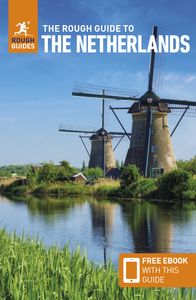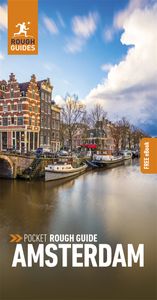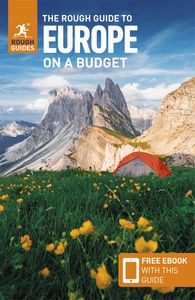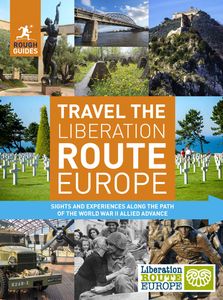Northwest Overijssel
The closing of the Zuider Zee and the draining of the Noordoostpolder transformed northwest Overijssel: not only were the area’s seaports cut off from the ocean, but they were placed firmly inland with only a narrow channel, the Vollenhover Kanaal, separating them from the new polder. As a result, Vollenhove and more especially Blokzijl, the two main seaports concerned, reinvented themselves as holiday destinations and today hundreds of Dutch city folk come here to sail and cycle.
Traditionally, both Vollenhove and Blokzijl looked firmly out across the ocean, doing their best to ignore the moor and marshland villages that lay inland. They were not alone: for many centuries this was one of the most neglected corners of the country and things only began to pick up in the 1800s, when the “Society of Charity” established a series of agricultural colonies here. The Dutch bourgeoisie were, however, as wary of the pauper as their Victorian counterparts in Britain and the 1900 Baedeker, when surveying the colonies, noted approvingly that “the houses are visited almost daily by the superintending officials and the strictest discipline is everywhere observed”. The villagers were reliant on peat for fuel and their haphazard diggings, spread over several centuries, created the canals, lakes and ponds that now lattice the area, attracting tourists by the boatload. The big pull is picture-postcard Giethoorn, whose mazy canals are flanked by splendid thatched cottages, but try to avoid visiting in the height of the season, when the crowds can get oppressive.
Blokzijl
Tiny Blokzijl, some 5km north of Vollenhove, is the prettiest of the area’s former seaports, its cobweb of narrow alleys and slim canals surrounding a trim little harbour, which is now connected to the Vollenhover Kanaal. The town once prospered from the export of peat and boasts dozens of seventeenth-century buildings, dating from its heyday. The most conspicuous is the Grote Kerk, which, with its splendid wooden pulpit and ceiling, was one of the country’s first Protestant churches.
Giethoorn
Giethoorn's origins are really rather odd. No one gave much thought to this marshy, infertile chunk of land until the thirteenth century, when the local landowner gifted it to an obscure religious sect. Perhaps to his surprise, the colonists made a go of things, eking out a living from local peat deposits and discovering, during their digs, the horns of hundreds of goats, which are presumed to have been the victims of the great St Elizabeth’s Day flood of 1170; duly impressed, the residents named the place Geytenhoren (“goats’ horns”). Later, the settlers dug canals to transport the peat and the diggings flooded, thus creating the watery network that has become the number one tourist attraction hereabouts – and no wonder: Giethoorn is extraordinarily picturesque, its slender brown-green waterways overseen by lovely thatched cottages, shaded by mature trees and crisscrossed by pretty humpbacked footbridges. The only fly in the ointment is Giethoorn’s popularity: avoid the centre of the village in the summer, when the place heaves with tour groups.
The Veluwe
Stretching west of the River IJssel, Gelderland’s Veluwe (literally “Bad Land”) is an expanse of heath, woodland and sandy dune that lies sandwiched between Apeldoorn in the east, Amersfoort to the west, Arnhem in the south and the Veluwemeer waterway to the north. For centuries these infertile lands lay pretty much deserted, but today they make up the country’s busiest holiday centre, dotted with a profusion of campsites, bungalow parks and second homes. The only part of the Veluwe to have survived aesthetically intact is the Nationaal Park de Hoge Veluwe, a slab of protected land lying just to the north of Arnhem – and home to one of the country’s most vaunted art galleries, the Kröller-Müller Museum.
Nationaal Park de Hoge Veluwe
One of the region’s most popular attractions, the Nationaal Park de Hoge Veluwe is an expanse of sandy heaths, lakes, dunes and woodland crisscrossed by cycle trails, with a number of hides from which you can observe its varied fauna. The park was formerly the private estate of the Kröller-Müllers: born near Essen in 1869, Hèléne Kröller-Müller came from a wealthy family who made their money in the manufacture of blast furnaces, while her husband, the ever-so-discreet Anton came from a Rotterdam shipping family. Super-rich, the couple had a passionate desire to leave a grand bequest to the nation: a mixture of nature and culture, which would, Hèléne felt, “be an important lesson when showing the inherent refinement of a merchant’s family living at the beginning of the century”. She collected the art, Anton the land and its animals – the moufflons (wild sheep) were, for example imported from Corsica – and in the 1930s ownership of the whole estate was transferred to the nation on the condition that a museum was built inside the park. The resulting Kröller-Müller Museum opened in 1938 with Hèléne acting as manager until her death in 1939, and a Sculpture Garden was added a few years later.
The Kröller-Müller Museum
At the heart of the Hoge Veluwe National Park, the Kröller-Müller Museum houses the private art collection of the Kröller-Müllers. It’s one of the country’s finest art museums, comprising a wide cross section of modern European art from Impressionism to Cubism and beyond. It’s housed in a low-slung building that was built for the collection in 1938 by the much-lauded Belgian architect van de Velde with a new wing added in the 1970s to create a T-shape: the bulk of the collection is displayed in the original wing. There’s not enough space to exhibit all the museum’s paintings at any one time, so what’s on show is regularly rotated – though key works by the likes of Mondrian and van Gogh are pretty much guaranteed to be on display – and there’s also a lively programme of temporary exhibitions. The works of individual artists are not necessarily exhibited together, which can be frustrating if you are keen to see the work of a particular painter: to help you navigate, the museum supplies a free information booklet with museum plans entitled “12 Masterpieces”.
Vincent van Gogh
Hèléne Kröller-Müller’s favourite artist was Vincent van Gogh, whom she considered to be one of the “great spirits of modern art”, and the collection reflects her enthusiasm: the museum owns 91 of his paintings and 180 drawings, representing the largest collection of his works in the world bar the Van Gogh Museum in Amsterdam. Of the earlier canvases, look out for The Potato Eaters and Head of a Peasant with a Pipe, both rough, unsentimental paintings of labourers from around his parents’ home in Brabant. His penetrating Self-Portrait from 1887 is a superb example of his work during his years in Paris, the eyes fixed on the observer, the head and background a swirl of grainy colour and streaky brushstrokes. One of his famous sunflower paintings also dates from this period, an extraordinary work of alternately thick and thin paintwork in dazzlingly sharp detail and colour. The joyful Café Terrace at Night and Bridge at Arles, with its rickety bridge and disturbed circles of water spreading from the washerwomen on the riverbank, are from his months in Arles in 1888, one of the high points of his troubled life.
The Toorops and Mondrian
Other highlights of the museum’s collection include several revealing self-portraits by Charley Toorop (1891–1955), one of the most skilled and sensitive of twentieth-century Dutch artists, as well as a number of key works by her father, Jan Toorop, (1858–1928), from his early pointillist studies to later, turn-of-the-century works more reminiscent of Aubrey Beardsley and the Art Nouveau movement. Piet Mondrian is well represented, too: his 1909 Beach near Domburg is a good example of his more stylized approach to landscape painting, a development from his earlier sombre-coloured scenes in the Dutch tradition. In 1909 Mondrian moved to Paris, and his contact with Cubism transformed his work, as illustrated by his Composition of 1917: simple flat rectangles of colour with the elimination of any identifiable object, the epitome of the De Stijl approach. One surprise is an early Picasso, Portrait of a Woman, from 1901, a classic post-Impressionist canvas very dissimilar from his more famous works.
The Sculpture Garden
Outside the Kröller-Müller Museum, the Sculpture Garden is one of the largest in Europe. Some frankly bizarre creations reside within its 25 hectares, as well as works by Auguste Rodin, Jacob Epstein and Barbara Hepworth. In contrast to the carefully conserved paintings of the museum, the sculptures are exposed to the weather and you can even clamber all over Jean Dubuffet’s Jardin d’email, one of his larger and more elaborate jokes.
Zutphen
Zutphen, 13km south of Deventer, is everything you might hope for in a Dutch country town: there’s no crass development here and the centre musters dozens of old buildings set amid a medieval street plan that revolves around three long and very appealing piazzas – Groenmarkt, Houtmarkt and Zaadmarkt – with the disjointed seventeenth-century clock tower, the Wijnhuis marking the junction of the first two piazzas. Much of the centre is pedestrianized and, without a supermarket in sight, the town’s old-fashioned shops still flourish, as do its cafés and, in a quiet sort of way, its bars.
Sir Philip Sidney: or how to die heroically
It was here at Zutphen that Sir Philip Sidney, the English poet, soldier and courtier, met his end while fighting the Spanish in 1586. Every inch the Renaissance man, Sidney even managed to die in style: mortally wounded in the thigh – after having loaned his leg-armour to a friend – he offered his last cup of water to a wounded chum, protesting “thy need is greater than mine”.
Zwolle
Zwolle, the compact capital of Overijssel about 85km from Amsterdam, is on the up. Not so long ago, it was a dowdy sort of place, but it has recently attracted substantial investment and the results are plain to see in a flush of modern buildings and the revival of its old harbour, which is now jammed with sailing boats and vintage canal barges.
An ancient town, Zwolle achieved passing international fame when Thomas à Kempis settled here in 1399. Thereafter, it went on to prosper as one of the principal towns of the Hanseatic League, its burghers commissioning an extensive programme of public works designed to protect its citizens and impress their rivals. Within the city walls, German textiles were traded for Baltic fish and grain, or more exotic products from Amsterdam like coffee, tea and tobacco. The boom lasted some two hundred years, but by the middle of the seventeenth century the success of Amsterdam and the general movement of trade to the west had undermined its economy – and Zwolle slipped into a sort of provincial reverie from which it is now emerging with much of its old centre intact and well preserved. Unusually, Zwolle’s moat has survived in fine fettle, encircling the centre and overlooked by nine, seventeenth-century earthen bastions that once protected the city. These bastions are seen to fine advantage on the walk in from the train station with fountains playing in the moat and the fortifications clearly visible among the trees.






















